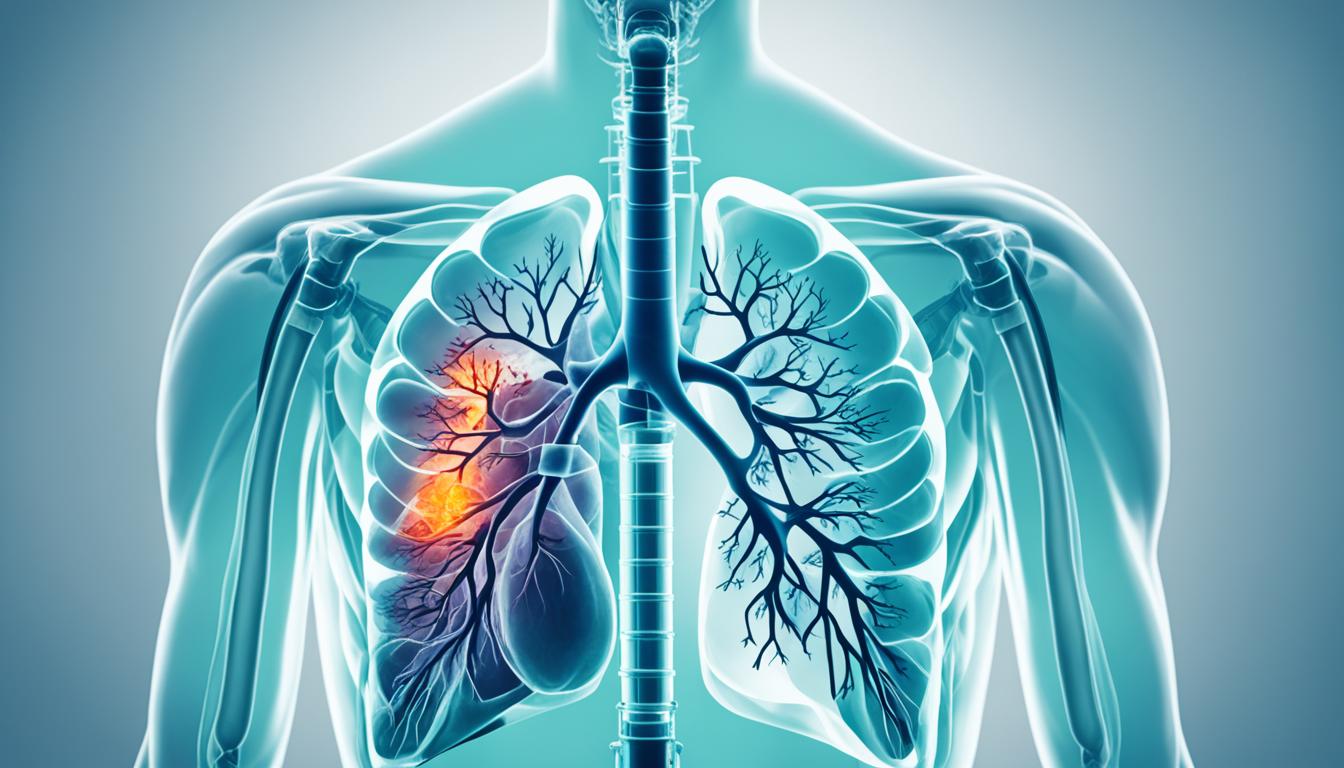Pneumothorax happens when air builds up in the space around your lungs, causing it to collapse. This issue is called a collapsed lung and can make breathing hard and painful. Learning about its signs, what causes it, how doctors find it, and the ways to treat it is key to getting better.
Key Takeaways:
- Pneumothorax is the accumulation of air in the pleural space, resulting in a collapsed lung.
- Common symptoms include sudden chest pain, dry cough, and shortness of breath.
- Chest trauma, lung diseases like COPD, and certain medical procedures are common causes of pneumothorax.
- Diagnosis is typically made through imaging tests such as X-rays or CT scans.
- Treatment options range from observation and rest to using a chest tube or surgery.
- Stem cell therapy shows promise in repairing lung tissue and may be a potential treatment option for pneumothorax in the future.
Recognizing the Symptoms of Pneumothorax
A collapsed lung or pneumothorax has various symptoms. It’s key to notice these signs early. This can help stop the problem from getting worse.
Chest Pain
Sharp chest pain is a key sign of pneumothorax. This pain gets worse with deep breaths or coughs. It feels like a sharp stab in your chest and can be very uncomfortable.
Dry Cough
A chronic and dry cough might mean a pneumothorax. This cough happens because the air in the chest makes the airways irritated.
Shortness of Breath
Shortness of breath is another big symptom. How bad it is depends on how much the lung has collapsed. It can range from a slight difficulty in breathing to a more severe struggle for air.
In rare, severe cases, symptoms can be life-threatening. They include a rapid heart rate, low blood pressure, and blue skin. This is due to not getting enough oxygen. If someone shows these signs, they need to see a doctor right away.
Image
| Symptom | Description |
|---|---|
| Chest Pain | Sudden and sharp pain that gets worse with deep breaths or coughs. |
| Dry Cough | An ongoing cough with no phlegm. |
| Shortness of Breath | It could be mild or severe, based on lung collapse. |
Causes and Risk Factors of Pneumothorax
Pneumothorax, known as a collapsed lung, has many causes and risks. Knowing these helps protect lung health. It’s key to staying healthy.
Chest Trauma
Rib fractures and accidents often cause pneumothorax. They damage lung tissue, letting air into the chest cavity.
Lung Diseases
Chronic lung issues like COPD and cystic fibrosis make lungs weaker. This leads to a higher risk of lung collapse.
Medical Procedures
Some treatments can cause pneumothorax. Procedures like lung biopsies and catheter insertions may accidentally harm the lung.
Smoking
Smoking is a major pneumothorax risk. It harms lung tissue and increases the chance of lung issues. Quitting smoking is key to reducing this risk.
Family History
If a family member had pneumothorax, one’s risk is higher. This suggests pneumothorax can be inherited.
Body Type
Tall, thin people face greater pneumothorax risk. Their chest shape and lower muscle protection make lungs more prone to damage.
Knowing these risks helps prevent pneumothorax. Tips include safe behaviors, managing lung diseases, and living healthily. These steps are important for good lung health.
Stem Cell Therapy as a Potential Treatment for Pneumothorax
Stem cell therapy is a new way to treat pneumothorax. It shows great promise in fixing lung damage. Studies in animals have found that it can help lung function and cut down on swelling.
This therapy is not available everywhere for pneumothorax yet. But, it’s very exciting because it might help repair lung damage. It opens up new doors for the future of medicine by focusing on fixing and regrowing lung tissue.
But, we need more research to know if it’s safe and really works for pneumothorax in humans. Studies with people are very important. They will tell us if stem cell therapy should be used more to help manage pneumothorax.
Stem cell therapy gives hope to those with pneumothorax. More work is being done to make this treatment even better. The goal is to see if it can really help heal and regrow lung tissues.

